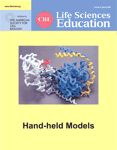Abstract
We conducted a controlled investigation to examine whether a combination of computer imagery and tactile tools helps introductory cell biology laboratory undergraduate students better learn about protein structure/function relationships as compared with computer imagery alone. In all five laboratory sections, students used the molecular imaging program, Protein Explorer (PE). In the three experimental sections, three-dimensional physical models were made available to the students, in addition to PE. Student learning was assessed via oral and written research summaries and videotaped interviews. Differences between the experimental and control group students were not found in our typical course assessments such as research papers, but rather were revealed during one-on-one interviews with students at the end of the semester. A subset of students in the experimental group produced superior answers to some higher-order interview questions as compared with students in the control group. During the interview, students in both groups preferred to use either the hand-held models alone or in combination with the PE imaging program. Students typically did not use any tools when answering knowledge (lower-level thinking) questions, but when challenged with higher-level thinking questions, students in both the control and experimental groups elected to use the models.



